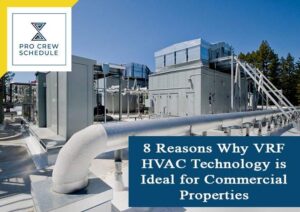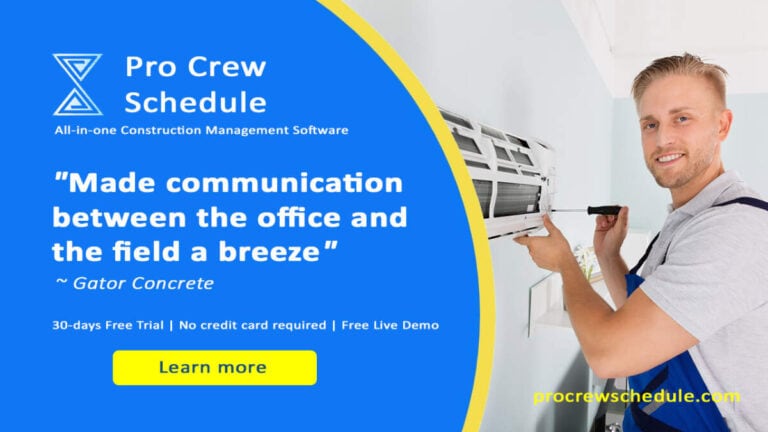Variable Refrigerant Flow (VRF) has instantly become a buzzword in the HVAC industry, particularly in commercial applications. While VRF HVAC technology has been utilized across the globe over three years, it has only become accessible and widely used in the U.S. ever since the early 2000s. VRF HVAC tech has instantly become famous for its efficiency as well as its ability to produce a promising ROI (return of investment).
Leveraging this particular technology provides many benefits to your clients, whether they are business owners or commercial property managers. With your client’s continuous search for energy efficiency, figuring out if a VRF system is a suitable option often requires careful consideration. In this blog, we’ll discuss more on VRF, including the many benefits it can provide, especially for commercial HVAC applications.
What is Variable Refrigerant Flow (VRF)?
VRF is an HVAC technology used to make a large-scale ductless system that can perform efficiently at a higher capacity. This technology is being used to provide both heating and cooling to various sections within one general space. This specific design of the VRF system largely depends on the application. For instance, commercial applications may require a unique approach compared to VRF HVAC systems separately designed for residential properties.
Like any traditional HVAC system used for light commercial spaces, a VRF HVAC system is refrigerant-based and air-cooled, typically using indoor fan coil units and outdoor condenser units. The similarity of the two stops there. But VRF systems are considered a non-traditional type of HVAC system because they have a much higher capacity and a much larger scale. These systems are a multi-system that comprises multiple indoor units typically lined with a central outdoor unit.
VRF HVAC systems integrate with today’s most advanced, energy-efficient technology, including:
- Capacity-modulated inverter duty compressors
- Outdoor fans that generally operate using Variable frequency drive (VFD) motors
- Variable speed compressors
- Indoor units that function using ECM or electronically commutated motors
- Hence, with VRF technology, one system facilitates the operation of various indoor zones. They might be either a heat recovery system that may provide both cooling and heating or a heat pump system that provides cooling or heating at the same time. As of today, variable refrigerant flow systems are presently the hot trend today in commercial heating, ventilation, and air conditioning system designs. Its zoning capabilities, superior efficiency, and flexibility prove significant factors in why it is the best choice.
- Below are the types of spaces ideal for VRF-HVAC systems:
- Mixed-used facilities that are very tough to cool and heat with standard equipment.
- Hotels, where individual comfort is often demanded
- Restaurants with well-defined heating and cooling operation modes
- Schools where every zone has differing HVAC requirements
- Retail stores and spaces with varying needs and essentials between tenants
- Medical facilities that often require accurate temperature and air quality control
- High-end commercial properties that demand superior zoning
- Lastly, anywhere that usually requires customized cooling and heating over multiple zones.
Many Benefits of VRF Technology for Commercial Properties
Variable refrigerant flow (VRF) HVAC systems are not a new HVAC tech, but they are relatively new to the U.S. market. The VFR system market was currently valued at $10.65 billion last 2019, and it is being projected to reach $30 billion by 2025, according to the April 2020 report from Markets and Markets. In just a short time, VRF tech is quickly acknowledged mainly because of its energy efficiency and several other advantages. Let’s go over now the top benefits of VRF HVAC systems:
1. VRF systems are energy-efficient
One of the best features of VRF HVAC systems is the energy-efficiency. These systems are purposely designed to supply the right amount of refrigerant to every air handler. Air handlers are responsible for cooling a room based upon the present conditions. Hence, it only means that energy waste is reduced. As a result, the system runs lesser frequently while at a lower capacity and can still maintain the room comfortably.
2. VRF systems are solid and provide flexible installation
Another advantage of VRF systems is that the main equipment itself is compact, ideal for small office spaces. There’s no need for considerable areas to house the heating and cooling equipment by choosing this system type. In the same way, there are no distribution fans, water pumps, or pipes required to operate. As a result, it translates to lesser room needed for the air conditioning system.
3. VRF system provides comfort consistency
Having the VRF system, the compressor unit effectively identifies the requirements for every zone of the commercial building. Thus, it can immediately provide the exact amount of refrigerant necessary for every air handling unit. With an accurate airflow, the VRF system operates to eliminate the hot or cold spots effectively. Not to mention, the system itself makes humidity issues become a thing from the past.
One of a project manager’s many tasks is to ensure that the VRF system functions appropriately upon installation. Many areas are crucial to determine and track, including the occupancy classification, room volume calculation and the amount of refrigerant needed in the system.
4. VRF System has a dual operation (Heating and Cooling)
Another best feature of VRF HVAC tech is the capacity to provide comfort control, either cooling or heating, in various spaces of the same building. Comfort control is being set up via VRF branch piping. The systems also utilize less energy since they are designed to deliver the right amount of cooking via piping in accordance with present conditions. It might run at a low capacity as it maintains the routine and intentionally seizes the cooling procedures’ heat.
5. VRF systems are easier to control
With the continuous advancement of technology, the system can come up with basic features of adjustments. The main target is the temperature setting for each zone in the building. With mobile phones, making adjustments is easier. Here, there’s no need to purchase any costly building management software since VRF systems already have built-in control systems.
6. VRF system have lesser downtime
Since the VRF HVAC system is designed to operate only when necessary and when under partial-load conditions, there can be lesser wear and tear on some parts. Hence, expect only fewer breakdowns. If something goes mistaken with one air handler, other air handlers are not quickly affected. Therefore, the whole space cannot be effected without air conditioning at once.
Project management for construction and HVAC is necessary to implement once the VRF system is installed. Doing so will help HVAC professionals to track every work done, including the participating crew members.
7. VRF Systems don’t need ducts
With this system, the air handlers are tiny. Hence, it is not necessary to require duct with the older equipment or devices. Additionally, there’s no need to have large space in the walls and ceilings for the equipment during the installation phase. Variable refrigerant flow systems are made to provide either cooling or heating. It is very efficient because it often reuses the generated heat during the cooling process to warm up several parts of the building.
8. VRF systems are easy to install
To deploy a VRF HVAC system is straightforward. It can largely interface with the present architecture when being necessary. It can also remove disruption and downtime that usually involved utilities work in your client’s business. As a result, it helps in making the deployment or installation as painless as possible. Given the host advantages offered by VRF HVAC systems, it truly makes for a sensible option when it comes to commercial spaces, be it in a new setup or when replacing old HVAC systems.
Getting Edge with Subcontractor Scheduling Software
In order to grow and expand HVAC businesses, owners and contractors need to optimize their HVAC business plan. In addition to optimizing business plans, it is also crucial to adapt emerging HVAC techs. The advantages of HVAC techs like project management software are beyond. Time marches on, and many technologies started to evolve. Pro Crew Software Schedule is considered as one best option. This advanced software solution is among the very useful project management tools that help your HVAC business getting an edge in the industry, becoming more competitive as possible, setting you apart from your competitors.
Request a FREE live demo and experience the Pro Crew Schedule firsthand! So now let’s discover the many advantages this construction scheduling software offers:
- Tracking project evolution (time, costs, completion, etc.)
- Time, scheduling and construction crew management
- Real-time collaboration and team communication
- File and document sharing
- Resource allocation
- Effective project planning
- Easy to use and explore
- Accessible anytime and anywhere
Key Takeaways
To conclude, VRF systems can provide the most flexible installation, energy-saving cooling feature, and heating comfort, which is considered the ideal alternative to traditional HVAC systems. All of these VRF system functions are primarily possible due to their efficient and strong VRF piping and joints. For HVAC professionals, hopefully, this blog may give you helpful insights about VFR HVAC techs, helping you next time to determine whether it’s right for your client or not.







